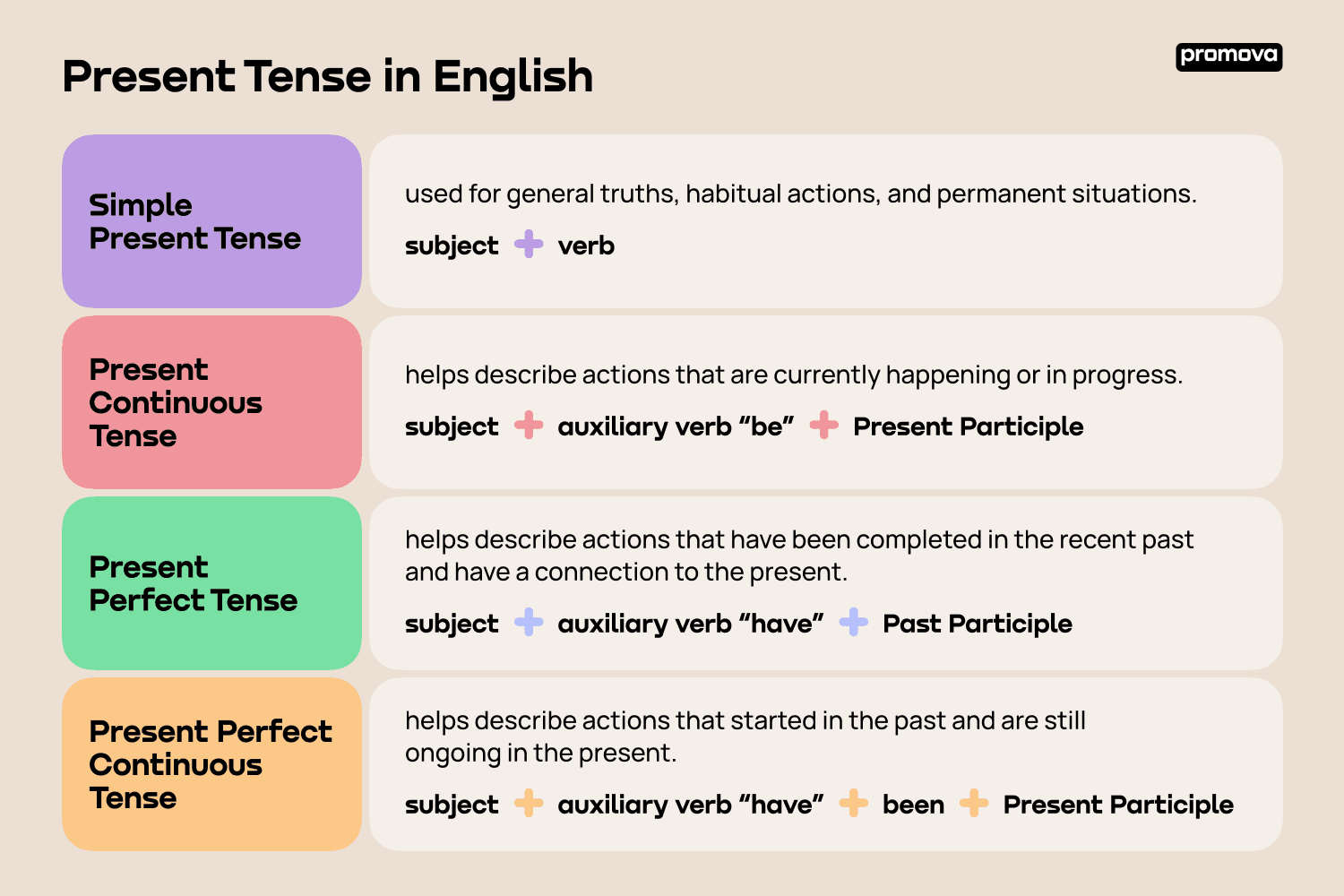Present Tense in English
Contents
The present tense is the most commonly used tense in the English language, and understanding how to use it correctly is essential for effective communication. In this reference, we will explain what present tense means in English, the types of present tenses, the difference between present tense and other tenses, present tense examples in different situations, how to form every present tense, common mistakes to avoid when using present tense, present tense words and their meaning, and a summary of everything you need to know in general.
What is Present Tense in English?
Present tense in English refers to the verb form that expresses what is happening now. It is used to describe actions that are currently taking place, habitual actions, thoughts, and feelings. For example, "I eat breakfast every day" is in the present tense because it describes a habitual action that occurs regularly.
Types of Present Tenses
There are four kinds of present tense in English: simple present, present continuous, present perfect, and present perfect continuous.
Simple Present Tense
The simple present tense is used for general truths, habitual actions, and permanent situations. So, "The sun rises in the east" is in the simple present tense because it is a general truth.
The formula for Simple Present is
Subject + Verb. For example, "He eats lunch."
Present Continuous Tense
The present continuous tense helps describe actions that are currently happening or in progress. For example, "I am writing an article" is in the present continuous tense because it describes an action that is currently happening.
The formula for Present Continuous is
Subject + Auxiliary Verb “be” + Present Participle. For example, "She is running."
Present Perfect Tense
The present perfect tense helps describe actions that have been completed in the recent past and have a connection to the present. For example, "I have eaten breakfast" is in the present perfect tense because it describes a completed action that has a connection to the present.
The formula for Present Perfect is
Subject + Auxiliary Verb “have” + Past Participle. For example, "She has finished."
Present Perfect Continuous Tense
The present perfect continuous tense helps describe actions that started in the past and are still ongoing in the present. For example, "I have been writing this article for an hour" is in the present perfect continuous tense because it describes an action that started in the past and is still occurring in the present.
The formula for Present Perfect Continuous is
Subject + Auxiliary Verb “have” + Been + Present Participle. For example, "She has been studying."

The Difference Between Present Tense and Other Tenses
The present tense is different from other tenses because it expresses what is happening now, while other tenses describe actions that have happened in the past or will happen in the future. For example, "I will eat breakfast tomorrow" is in the future tense because it describes an action that hasn't happened yet.
Examples of Present Tense in Different Situations
Present tense is used in various situations in English. Here are some examples:
In Daily Conversations
- "I wake up at 9 am every day."
- "I love going to the beach."
- "Open the door!"
In News Reports
- "The government announces new policies to tackle climate change."
- "The Prime Minister speaks about the importance of education."
- "The police investigate the incident."
In Literature
- "She walks in beauty, like the night."
- "The trees whisper secrets in the wind."
- “The stars twinkle in the sky.”
7
How to Form Every Present Tense
Each type of present tense has a unique formation. We've provided the formulas earlier, but let's take a look in more detail.
Simple Present Tense
To form the simple present tense, use the base form of the verb (infinitive) for all subjects except third-person singular, which adds -s or -es to the base form.
Examples:
- I walk to work every day.
- She eats breakfast at 7 am.
Present Continuous Tense
To form the present continuous tense, use the present participle of the verb (base form + -ing) with the auxiliary verb "to be."
Examples:
- I am writing an article.
- They are watching a movie.
Present Perfect Tense
To form the present perfect tense, use the present participle of the verb with the auxiliary verb "to have."
Examples:
- I have eaten breakfast.
- She has studied English for five years.
Present Perfect Continuous Tense
To form the present perfect continuous tense, use the present participle of the verb with the auxiliary verbs "to have" and "to be."
Examples:
- I have been writing this article for an hour.
- They have been living in New York since 2010.
Common Mistakes to Avoid When Using Present Tense
Things to avoid when using the present tense:
- Confusing the present tense with other tenses: Make sure you use the present tense when describing actions that are happening now.
- Forgetting to add -s or -es to third-person singular verbs: Remember to add -s or -es to third-person singular verbs, such as "he," "she," or "it."
- Using the wrong form of the verb: Use the correct form of the verb for each type of present tense.
Summary
Each type of present tense has a unique formation, and it is essential to use the correct form when describing actions that are happening now, habitual actions, thoughts, and feelings. If you practice and avoid common mistakes, using the present tense will become second nature!



Comments